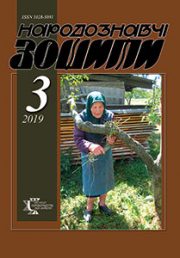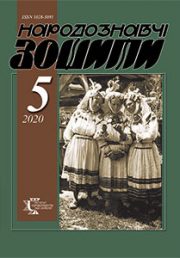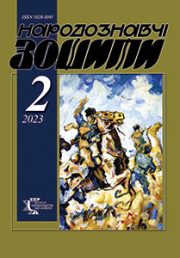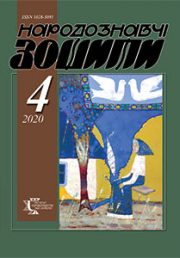The Ethnology Notebooks. 2019, № 6 (150), 1488—1498
UDK730.071.1+76.071.1](477)”18″(092)+[730+76](477)”18″
DOI https://doi.org/10.15407/nz2019.06.1488
THE WORKS OF VLADISLAV PELCHARSKY PERIOD OF STUDYING
KUPCHYNSKA Larysa
ORCID ID: http://orcid.org/0000-0001-6461-4819
Ph. D. in Art Studies, Associate Professor,
Researcher of the Vasyl Stefanyk National Scientific
Library of Ukraine in Lviv,
2, Stefanyk St., 79000, Lviv, Ukraine
e-mail: oklarysa@gmail.com
Abstract. Vladislav Pelcharsky (1862—1891) is a sculptor who is little known in the history of Ukrainian art. The main information about his life and work today is presented by small publications in periodicals of the nineteenth century end, catalogs of exhibitions he was participating in, as well as in encyclopedias. Archival materials and works of the artist — drawings and sculptures — are the article’s basis. Based on the research the new data from the biography of the artist is presented. These materials relate to his studies in Vienna, in the High Art-Industrial School and the Vienna Academy of Fine Arts first of all, as well as it relates to his perfection of mastery in Rome. It is important given that the experience gained by the artist in Austria and Italy is the basis of his activities in Paris. His drawings, mainly academic studios of male and female nature, are introduced in the scientific circle. Particular attention is paid to the subject of the drawings, the level of performance of tasks facing the student of the leading educational institutions was analyzed. It was proved that while working on the tasks author was guided by the best examples of antique art and baroque. The artist thoroughly studied and drew in detail every part of works of the past centuries. Sculptures, which remained very small, are significant part of the artist heritage. Their research involves photographs that give a general idea of some works. The sculptural compositions «Madonna with the Child» and «Escape to Egypt» stored in the museums of Lviv and Krakow are considered deeper. Given that it is an example of a new figurative and artistic solution to religious themes in temple sculpture, the sculptures composition, silhouette, masses and size are analyzed, the connection of the form with the content is revealed and so on. The article mentions a collection of photographs and reproductions of artistic works of different times that belonged to the artist. The new data on V. Pelcharsky creative activity presented in the article is evidence of his professionalism recognized in the world, but not appreciated in the homeland.
Keywords: Vladislav Pelcharsky, Vienna, Rome, Paris, academic drawing, sculpture, photographs, reproductions.
Received 31.10.2019
REFERENCES
Hubner-Wojciechowska, J., Makowska, U. and Biriulow, J. (2003). Pelcharski Wladyslaw. In: Dictionary of the Polish artists in Poland (passed away before 1966) artists, sculptors, graphics (Vol. 7, pp. 4, 5). Warszawa [in Polish].
Nemo. (1891). Above Seine. Paris, on October 20. Edge, 42, 4—6 [in Polish].
Swieykowski, E.(1905). Diary of the Society of friends of fine arts in Krakow 1854-1904: Fifty years of activity for a home art. Krakow: Druk W.L. Anczyca and Unions [in Polish].
Catalogue of exhibition of the Society of friends of fine arts in Krakow 9. (1889). Krakow: In printing-house «Time» [in Polish].
Explanation of painting, sculpture, erects, gravure and lithography from proposed living artists in a palace from Champs Elyseess 1e May, 1889. (1889). Paris [in French].
Explanation of painting, sculpture, erects, gravure and lithography from proposed living artists in a palace from Champs Elyseess 1er May, 1890. (1890). Paris [in French].
R… (1889). Rewards in a world exhibition. Polish bulletin. Literature, scientific and artistic, 43, 150—152 [in French].
Explanation of painting, sculpture, erects, gravure and lithography from proposed living artists in a palace from Champs Elyseess 1er May, 1891. (1891). Paris [in French].
(1891). Among komposition. Musical, theatrical and artistic echo 399, 279 [in Polish].
Suicide of the Polish artist in Paris. (1891). Time, 244, 3 [in Polish].
Review from Lviv… (1891). World: the two-week illustrated Paper, 21, 518 [in Polish].
National enterprise of the name of Ossolinsky. (1893). Polish diary, 236, 3 [in Polish].
Catalogue of exhibition of the Society of friends of fine arts in Krakow, 20. (1891). Krakow: «Time» [in Polish].
T.[Trawiсsny, F.].(1889). Fine arts: living room. Polish bulletin. Literature, scientific and artistic, 41, 71—73 [in French].
List from artists of Poland has proposed in 1891. (1891). Polish bulletin. Literature, scientific and artistic, 51, 132 [in French].
Trawinski.(1889). Fine arts: Poland has an exhibition of art from 1889. Polish bulletin. Literature, scientific and artistic, 42, 111—116 [in French].
Explorer on Museum of the name of princes of Lubomirsky in Lviv. (1909). Lviv: From the printing-house of national Enterprise named after Ossolinsky [in Polish].
Medyсski, A. (1937). Lviv. Illustrated explorer of city for visitors. Lviv: Polish Printing-house [in Polish].
National Polish Museum in Rapperswil. (1906). Krakow: Printing of W.L. Anczyca and unions [in Polish].
Biryulov, Yu. (2015). Lviv sculpture: from early classicism to avant-gardeism (mid XVIII — mid XX century). Lviv: Apriori [in Ukrainian].
Academy of educational arts of Vienna. University archive. Act № 118: Aufnahms-folias of I. Semester 1886/87 (Chronolog. Addition: alphabet. Register) [in German].
Academy of educational arts of Vienna. University archive. Act № 119: Aufnahms-folias of Ii. Semester 1886/87 (Chronolog. Addition: alphabet. Register) [in German].
Vasyl Stefanyk National Scientific Library of Ukraine in Lviv; Research Institute for Library’s Art Resources. Inwentarz rycin (22300—33664) (Manuscript) [in Polish].
Vasyl Stefanyk National Scientific Library of Ukraine in Lviv; Research Institute for Library’s Art Resources. Inwentarz rycin. Muzeum named by Ks. Lubomirsky in Lviv (1—461) (Manuscript) [in Polish].







